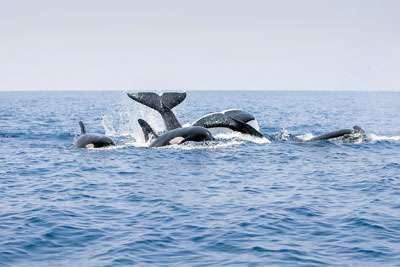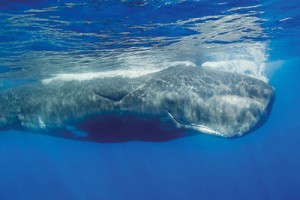News
Super pods of sperm whales put on marine spectacle

The eight-strong orca pod get ready to charge towards the sperm whales. Pix courtessy Andrew Sutton
While observing a super pod of nearly 100 sperm whales, marine mammal expert Ranil Nanayakkara witnessed a rare occasion when killer whales attacked the marine giants in the seas off Kalpitiya. It was an epic battle.
Sri Lanka is famous for wildlife spectacles such as this along with the largest gathering of Asian elephants, huge pods of blue whales and rare sightings of leopards.
One spectacle in the making is super pods of sperm whales (physeter microcephalus). The sperm while is the largest âtoothed whaleâ which can dive to depths of 3,200 feet in search of its favourite food â the giant squid. Female sperm whales and their calves live in pods of 15-20 members, while males tend to roam alone in cooler waters closer to polar regions. A super pod of whales is formed when such smaller pods gather for feeding, socialising or mating. March to April seems to be the time such super pods form and in 2012 the largest such gathering consisting of over 100 individuals was recorded.
Marine biologist Ranil Nanayakkara who has studied the sperm whale super pods from 2010, left Kalpitiya shores on March 23 to scan the ocean specially for sperm whales. It turned out to be their lucky day when they witnessed the sperm whale super pod about 15 nautical miles from Kalpitiya at 9.15 am after travelling for about one hour. âThere were over 150 sperm whales on the ocean of around one kilometre. The super pod we saw consisted of 50 to 60 individuals,ââ Nanayakkara said.
Together with Ranil, British author Philip Hoare and photographer Andrew Sutton were on the boat and it was a show of a life time. The larger sperm whale males had joined the super pod and they witnessed love making on a massive scale. The team witnessed foreplay â rubbing against each other, tail slapping, spy hopping, rolling over. Even researchers could see the animalsâ aroused genitals and as they watched, a pair swam belly to belly under the boat.
The sperm whale is also famous for making sounds. It makes the loudest sounds of any animal and also emits morse-like âcodasâ used to communicate long distances. The sea is full of sound as well and Nanayakkara was listening to these codas using special ear phones.
The ocean was like an opera, said Nanayakkara.

A large male sperm whale that came to rescue the weaker pod
They observed a large male deviate from the super pod and swim rapidly northward. âWhen a sperm whale swims fast, its large head stays out of the water â so we could clearly say it was in a great hurry. Then several other large males started following the first one. Seeing several large male sperm whales moving northward we thought it could be an aggression related to mating, so we followed them,â Nanayakkara explained.
After travelling two or three kilometres, the team found the large males with a pod of about 10 females with younger whales. The males packed their bodies tightly and it was like several logs stacked tightly. The men in the boat also saw something else. One person in the boat alerted the others to a dolphin but to their surprise it was the unmistakable dorsal fin of an orca. The sperm whales had rushed to protect the pod that came under attack by the orcas.
The black and white orca (orcinus orca), is a mid-sized toothed whale. it is the largest member of the dolphin family and became a popular after being featured in the movie âFree Willyâ. But the orca is not an innocent animal as it is an agile predator in the ocean also known as the âkiller whaleâ.
âIt was a pod of about eight orcas attacking a weaker maternity pod. The large males would have heard the distress call and had rushed to protect them. The males packed their bodies side by side tightly guarding the weaker whales from the predatory orcas,â Nanayakkara said. The water around the smaller pod was cloudy with orangish whale poop â a defense mechanism used by the distressed whales to conceal themselves from the predators.
Killer whale attacks on other whales have been reported on a handful of occasions previously. Working as a team, they usually challenge the weaker female or a calf to hunt it down. According to Nanayakkara, the orcas found in our waters is transient and they are born hunters.
âWe had also observed an amazing communal defense mechanism used by the sperm whales where the males encircle the weaker females and young putting their bodies in front of the attacking killer whales,â Nanayakkara said. This is a known as the âmarguerite formationâ, named after the shape of the flower by that name. In this formation, the heavy and powerful tail of an adult whale is pointed outward, readying to deliver lethal blows to any incoming attacker.

Ranil Nanayakkara Listening to the songs of sperm whales
The researchers also experienced a somewhat scary experience. Since the marguerite formation was not effective, the whales started using the boat as a cover to avoid the orcas. They moved to the other side of the boat when the orcas charged and a collision could have been dangerous.
This âbattle of the titansâ dragged on for more than an hour. The sperm whales finally made the orcas give up. Nanayakkara said there were about 20 killer whales at that time and it could also be the largest orca pod seen in Sri Lankan waters.
Nanayakkara said it was one of the amazing moments he had witnessed in his whole life.
| Know the sperm whaleThe head of the whale contains a liquid wax called spermaceti, from which the whale derives its name. Spermaceti was used in lubricants, oil lamps, and candles. Scientists have yet to understand its function, but believe it may help the animal regulate its buoyancy. Some also believe that the spermaceti has bio-acoustical amplification properties, enabling the whale to produce the loudest sounds of any animal.Mature males average 16 metres (52 ft) in length but some may reach 20.5 metres (67 ft), with the head representing up to one-third of the animal’s length. Capable of plunging to 2,250 metres (7,382 ft), it is the second deepest diving mammal, following only the Cuvier’s beaked whale. The sperm whale’s clicking vocalisation, a form of echolocation and communication, may be as loud as 230 decibels under water. The sperm whale has the largest brain of any animal on Earth, more than five times heavier than a human’s. Sperm whales can live for more than 60 years according to sources on the Web.Ambergris, a waste product from its digestive system, is still used as a fixative in perfumes. |

